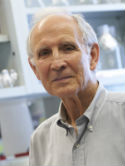Association of KIT exon 9 mutations with nongastric primary site and aggressive behavior: KIT mutation analysis and clinical correlates of 120 gastrointestinal stromal tumors Journal Article
| Authors: | Antonescu, C. R.; Sommer, G.; Sarran, L.; Tschernyavsky, S. J.; Riedel, E.; Woodruff, J. M.; Robson, M.; Maki, R.; Brennan, M. F.; Ladanyi, M.; DeMatteo, R. P.; Besmer, P. |
| Article Title: | Association of KIT exon 9 mutations with nongastric primary site and aggressive behavior: KIT mutation analysis and clinical correlates of 120 gastrointestinal stromal tumors |
| Abstract: | Purpose: Activating mutations of the KIT juxtamembrane region are the most common genetic events in gastrointestinal stromal tumors (GISTs) and have been noted as independent prognostic factors. The impact of KIT mutation in other regions, such as the extracellular or kinase domains, is not well-defined and fewer than 30 cases have been published to date. Experimental Design: One hundred twenty GISTs, confirmed by KIT immunoreactivity, were evaluated for the presence of KIT exon 9, 11, 13, and 17 mutations. The relation between the presence/type of KIT mutation and clinicopathological factors was analyzed using Fisher's exact test and log-rank test. Results: Forty-four % of the tumors were located in the stomach, 47% in the small bowel, 6% in the rectum, and 3% in the retroperitoneum. Overall, KIT mutations were detected in 78% of patients as follows: 67% in exon 11, 11% in exon 9, and none in exon 13 or 17. The types of KIT exon 11 mutations were heterogeneous and clustered in the classic "hot spot" at the 5′ end of exon 11. Seven % of cases showed internal tandem duplications (ITD) at the 3′ end of exon 11, in a region that we designate as a second hot spot for KIT mutations. Interestingly, these cases were associated with: female predominance, stomach location, occurrence in older patients, and favorable outcome. There were significant associations between exon 9 mutations and large tumor size (P < 0.001) and extragastric location (P = 0.02). Ten of these 13 patients with more than 1-year follow-up have developed recurrent disease. Conclusions: Most KIT-expressing GISTs show KIT mutations that are preferentially located within the classic hot spot of exon 11. In addition, we found an association between a second hot spot at the 3′end of exon 11, characterized by ITDs, and a subgroup of clinically indolent gastric GISTs in older females. KIT exon 9 mutations seem to define a distinct subset of GISTs, located predominantly in the small bowel and associated with an unfavorable clinical course. |
| Keywords: | immunohistochemistry; adolescent; adult; child; human tissue; school child; treatment outcome; aged; aged, 80 and over; middle aged; gene mutation; major clinical study; exon; mutation; exons; cancer recurrence; protein domain; gastrointestinal stromal tumor; proto-oncogene proteins c-kit; tumor volume; immunoreactivity; age; gastrointestinal neoplasms; amino acid sequence; molecular sequence data; sequence homology, amino acid; protein structure, tertiary; retroperitoneal tumor; dna mutational analysis; point mutation; disease control; rectum tumor; stomach tumor; oncogene c kit; small intestine tumor; humans; prognosis; human; male; female; priority journal; article |
| Journal Title: | Clinical Cancer Research |
| Volume: | 9 |
| Issue: | 9 |
| ISSN: | 1078-0432 |
| Publisher: | American Association for Cancer Research |
| Date Published: | 2003-08-15 |
| Start Page: | 3329 |
| End Page: | 3337 |
| Language: | English |
| PUBMED: | 12960119 |
| PROVIDER: | scopus |
| DOI/URL: | |
| Notes: | Export Date: 12 September 2014 -- Source: Scopus |
Citation Impact
MSK Authors
Related MSK Work











